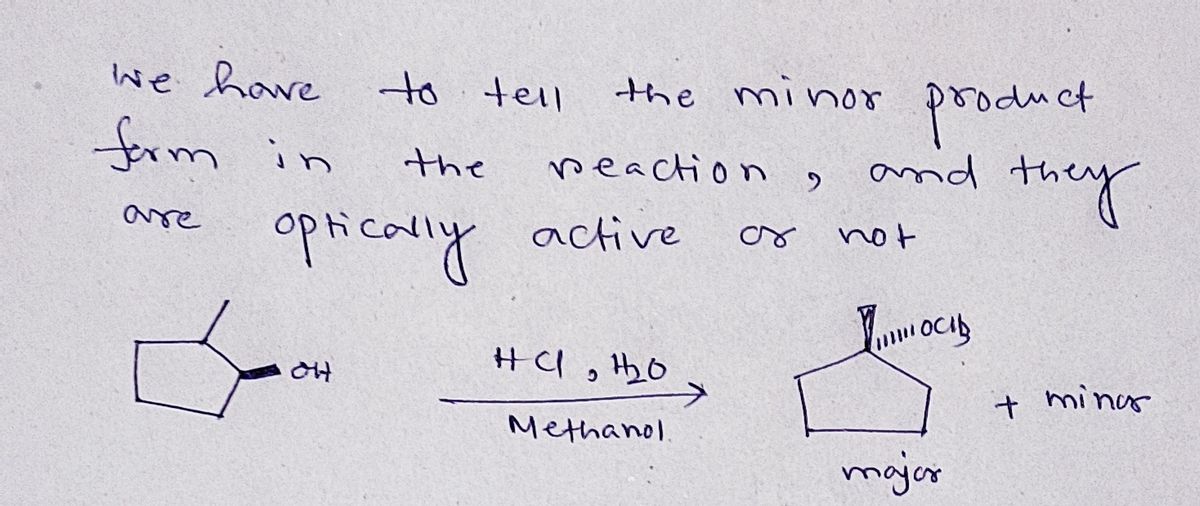04 4 + ryot Br 14. For the reaction below, predict the MAJOR product th product shown. OH HC1, H₂O methanol B Using proper arrow formalism, draw the mechani Make sure to indicate the rate-determining step (RDS
04 4 + ryot Br 14. For the reaction below, predict the MAJOR product th product shown. OH HC1, H₂O methanol B Using proper arrow formalism, draw the mechani Make sure to indicate the rate-determining step (RDS
Chemistry
10th Edition
ISBN:9781305957404
Author:Steven S. Zumdahl, Susan A. Zumdahl, Donald J. DeCoste
Publisher:Steven S. Zumdahl, Susan A. Zumdahl, Donald J. DeCoste
Chapter1: Chemical Foundations
Section: Chapter Questions
Problem 1RQ: Define and explain the differences between the following terms. a. law and theory b. theory and...
Related questions
Question
On this question below what is the predicted major product that we gonna put in the box provided ? And which one is minor product ? Are the products optically active can u explain why or why not ? Thank u

Transcribed Image Text:**Organic Chemistry Reaction Mechanism Exercise**
**14. Reaction Prediction Task**
For the reaction below, predict the MAJOR product that would form via a different mechanism than the product shown.
**Reaction Details:**
- Starting Material: Cyclopentanol
- Reagents: HCl, H₂O
- Solvent: Methanol
**Structure Observations:**
- The starting cyclopentane ring has an OH group attached.
- The proposed product changes this to an OCH₃ group.
**Task B: Mechanism Diagram**
Using proper arrow formalism, draw the mechanism for the formation of the product that is shown. Make sure to indicate the rate-determining step (RDS). DO NOT include transition states here.
**Box:**
- Leave space for the drawn mechanism.
**Additional Information:**
This exercise involves recognizing the major product and visualizing the mechanism using appropriate chemical notations. The focus is on understanding the stepwise transformation and identifying the key transformations involved.
Expert Solution
Step 1

Step by step
Solved in 2 steps with 2 images

Knowledge Booster
Learn more about
Need a deep-dive on the concept behind this application? Look no further. Learn more about this topic, chemistry and related others by exploring similar questions and additional content below.Recommended textbooks for you

Chemistry
Chemistry
ISBN:
9781305957404
Author:
Steven S. Zumdahl, Susan A. Zumdahl, Donald J. DeCoste
Publisher:
Cengage Learning

Chemistry
Chemistry
ISBN:
9781259911156
Author:
Raymond Chang Dr., Jason Overby Professor
Publisher:
McGraw-Hill Education

Principles of Instrumental Analysis
Chemistry
ISBN:
9781305577213
Author:
Douglas A. Skoog, F. James Holler, Stanley R. Crouch
Publisher:
Cengage Learning

Chemistry
Chemistry
ISBN:
9781305957404
Author:
Steven S. Zumdahl, Susan A. Zumdahl, Donald J. DeCoste
Publisher:
Cengage Learning

Chemistry
Chemistry
ISBN:
9781259911156
Author:
Raymond Chang Dr., Jason Overby Professor
Publisher:
McGraw-Hill Education

Principles of Instrumental Analysis
Chemistry
ISBN:
9781305577213
Author:
Douglas A. Skoog, F. James Holler, Stanley R. Crouch
Publisher:
Cengage Learning

Organic Chemistry
Chemistry
ISBN:
9780078021558
Author:
Janice Gorzynski Smith Dr.
Publisher:
McGraw-Hill Education

Chemistry: Principles and Reactions
Chemistry
ISBN:
9781305079373
Author:
William L. Masterton, Cecile N. Hurley
Publisher:
Cengage Learning

Elementary Principles of Chemical Processes, Bind…
Chemistry
ISBN:
9781118431221
Author:
Richard M. Felder, Ronald W. Rousseau, Lisa G. Bullard
Publisher:
WILEY